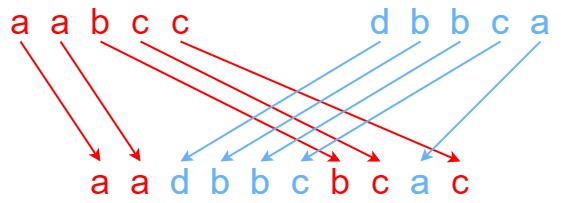Algorithm
Problem Nmae: 97. Interleaving String
Given strings s1, s2, and s3, find whether s3 is formed by an interleaving of s1 and s2.
An interleaving of two strings s and t is a configuration where s and t are divided into n and m
s = s1 + s2 + ... + snt = t1 + t2 + ... + tm|n - m| <= 1- The interleaving is
s1 + t1 + s2 + t2 + s3 + t3 + ...ort1 + s1 + t2 + s2 + t3 + s3 + ...
Note: a + b is the concatenation of strings a and b.
Example 1:

Input: s1 = "aabcc", s2 = "dbbca", s3 = "aadbbcbcac" Output: true Explanation: One way to obtain s3 is: Split s1 into s1 = "aa" + "bc" + "c", and s2 into s2 = "dbbc" + "a". Interleaving the two splits, we get "aa" + "dbbc" + "bc" + "a" + "c" = "aadbbcbcac". Since s3 can be obtained by interleaving s1 and s2, we return true.
Example 2:
Input: s1 = "aabcc", s2 = "dbbca", s3 = "aadbbbaccc" Output: false Explanation: Notice how it is impossible to interleave s2 with any other string to obtain s3.
Example 3:
Input: s1 = "", s2 = "", s3 = "" Output: true
Constraints:
0 <= s1.length, s2.length <= 1000 <= s3.length <= 200s1,s2, ands3consist of lowercase English letters.
Code Examples
#1 Code Example with Java Programming
Code -
Java Programming
class Solution {
public boolean isInterleave(String s1, String s2, String s3) {
if (s1.length() + s2.length() != s3.length()) {
return false;
}
Boolean[][] dp = new Boolean[s1.length()][s2.length()];
return isInterleaveHelper(s1, 0, s2, 0, s3, 0, dp);
}
private boolean isInterleaveHelper(String s1, int i1, String s2, int i2, String s3, int i3, Boolean[][] dp) {
if (i1 == s1.length()) {
return s2.substring(i2).equals(s3.substring(i3));
}
if (i2 == s2.length()) {
return s1.substring(i1).equals(s3.substring(i3));
}
if (dp[i1][i2] != null) {
return dp[i1][i2];
}
dp[i1][i2] = (s3.charAt(i3) == s1.charAt(i1) && isInterleaveHelper(s1, i1 + 1, s2, i2, s3, i3 + 1, dp)) ||
(s3.charAt(i3) == s2.charAt(i2) && isInterleaveHelper(s1, i1, s2, i2 + 1, s3, i3 + 1, dp));
return dp[i1][i2];
}
}
Input
Output
#2 Code Example with Javascript Programming
Code -
Javascript Programming
const isInterleave = function(s1, s2, s3) {
const len3 = s3.length
const len1 = s1.length
const len2 = s2.length
if(len1 + len2 !== len3) return false
const dp = Array.from({length: len1 + 1}, () => new Array(len2 + 1).fill(false))
for(let i = 0; i <= len1; i++) {
for(let j = 0; j < = len2; j++) {
if(i === 0 && j === 0) {
dp[i][j] = true
} else if(i === 0) {
dp[i][j] = dp[i][j - 1] && s2[j - 1] === s3[i + j - 1]
} else if(j === 0) {
dp[i][j] = dp[i - 1][j] && s1[i - 1] === s3[i + j - 1]
} else {
dp[i][j] = (dp[i - 1][j] && s1[i - 1] === s3[i + j - 1]) || (dp[i][j - 1] && s2[j - 1] === s3[i + j - 1]>
}
}
}
return dp[len1][len2]
};
Input
Output
#3 Code Example with Python Programming
Code -
Python Programming
class Solution:
def isInterleave(self, s1, s2, s3):
def dfs(i, j, k):
if (i, j, k) not in memo:
memo[(i, j, k)] = k>=l3 or (iInput
Output
#4 Code Example with C# Programming
Code -
C# Programming
namespace LeetCode
{
public class _097_InterleavingString
{
public bool IsInterleave(string s1, string s2, string s3)
{
if (s1.Length + s2.Length != s3.Length) return false;
var dp = new bool[s1.Length + 1, s2.Length + 1];
for (int i = 0; i < = s1.Length; i++)
{
for (int j = 0; j < = s2.Length; j++)
{
if (i == 0 && j == 0) dp[i, j] = true;
else if (i == 0) dp[i, j] = dp[i, j - 1] && s2[j - 1] == s3[i + j - 1];
else if (j == 0) dp[i, j] = dp[i - 1, j] && s1[i - 1] == s3[i + j - 1];
else
dp[i, j] = (dp[i, j - 1] && s2[j - 1] == s3[i + j - 1]) || (dp[i - 1, j] && s1[i - 1] == s3[i + j - 1]);
}
}
return dp[s1.Length, s2.Length];
}
}
}
Input
Output
